Ka-15: USSR first deck helicopter (part 2)
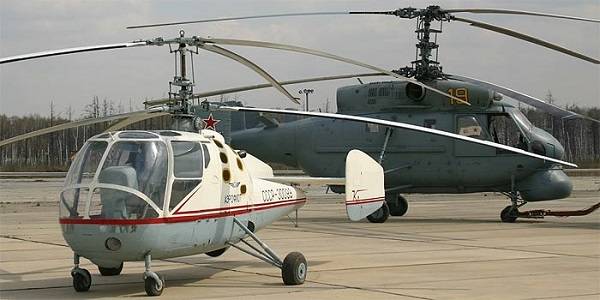
Predecessor and follower: Ka-15 on the background of Ka-25PL. Photos from http://militaryrussia.ru
The first experience with the use of deck helicopters of the Ka-10 coaxial circuit, developed at the OKB-2 Nikolay Kamov, convinced the fleet that he needed such machines. But the rotary-winged aircraft with a crew of one person and a small carrying capacity could perform only the functions of a liaison officer, and in some situations a scout. A larger payload machine was required, which would become one of the elements of the anti-submarine defense system, and could still serve as a lifeguard, a scout, and so on. In short, the fleet needed a universal deck helicopter, and, according to the naval command, only Kamov could give it.
The logic of the sailors is not difficult to understand. The Mil Design Bureau, although it worked very actively, was engaged in machines with a single-screw scheme, which were distinguished by large dimensions. You want, you do not want, and such helicopters need a tail boom, which means that a place for its landing and storage also needs more. And the Kamov coaxial machines were significantly smaller: their limiting dimensions were actually determined by the diameter of the rotor, and it was, by definition, smaller than the diameter of the same screw of a single-rotor machine.
In addition, the army attacked Michael Mil, who demanded rotorcraft for themselves. And the fleet, accustomed to, that its orders, if they overlap with the army, are carried out according to the residual principle, could not count on the speedy fulfillment of their helicopter orders. And the newly-formed - and just at the insistence of the fleet! - Kamovsky KB no other machines involved. And it was not going to engage. Because the chief designer Nikolai Kamov made his main bet on coaxial circuit machines.
Coaxial horse of Nikolay Kamov
Why did Nikolai Kamov, who quite successfully worked on the creation of autogyros and after the war, created the project of the single-rotor “YurKa” helicopter, in the end relied on machines of coaxial scheme? There is no unequivocal answer to this question: it could only be given by the general designer himself, but in his manuscript “Creation of the first Soviet helicopter” no word was said about it. Most likely, the final choice of the scheme Kamov led a set of reasons, which can be described in more detail.
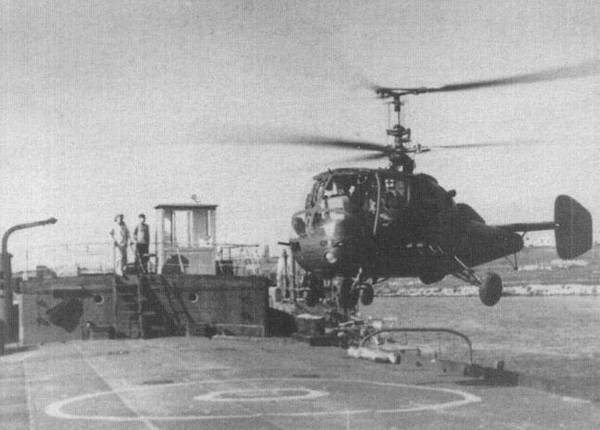
Ka-15 during state tests land on the deck of the ship. Photos from http://kollektsiya.ru
On the one hand, there was a purely hardware reason: Nikolai Kamov needed such a helicopter theme that would put him on equal footing with the former deputy plant manager at Ukhtomskaya, and by that time quite successful and influenced at the top by aircraft designer Mikhail Mil. By the end of the 1940-x, he had already brought his first production helicopter, the Mi-1, to state tests, and it was clear that it would not be possible to overtake him in the field of single-rotor machines. And working with coaxial helicopters was the very opportunity to find a niche in which Kamov had no competitors.
On the other hand, the coaxial scheme, despite its rarity, has a number of significant advantages over a single-screw one. Yes, it is more complicated and dangerous from the point of view that the bottom screw is in the zone of blowing with the top airflow. Yes, the builders of such helicopters have to decide what to do with the main threat - overlapping the ends of the upper and lower propeller blades. Yes, such helicopters have increased drag and noticeably greater height than single-rotor ones. But on the other hand, they are at least 15% more efficient, since the engine power is not selected to control the steering screw. They are much more compact: the same Ka-15 was half as long as the Mi-1, due to the absence of a tail boom. They have no cross connections in control: the first serial Kamov Ka-8 helicopter was much easier to fly than the Mi-1. Coaxial helicopters have the best maneuverability, since no other controls, except coaxial screws, are required for them - and time for their activation and reaction is not wasted. So, when flying in close airspace, with many obstacles, there are no competitors to slip out from under the landing gear to coaxial helicopters.
And thirdly, as far as one can guess, Nikolay Kamov, like any inventor who was generously gifted with talent, it was important to find your way in the aircraft industry and say your truly new word. In the area of single-rotor helicopters
he did not have such a chance. But to return to the sources - it suffices to recall the first Igor Sikorsky helicopter, built according to a coaxial scheme - it made sense. And it was Kamov who owns, in particular, the inventor's certificate for an invention called the “Helicopter rotor”, which in time became part of the wide practice called the coaxial screw column. And the total account of such testimonies received by the chief designer of the OKB-2, personally or in collaboration with colleagues, goes to the dozens - and almost all of them concern the coaxial scheme.
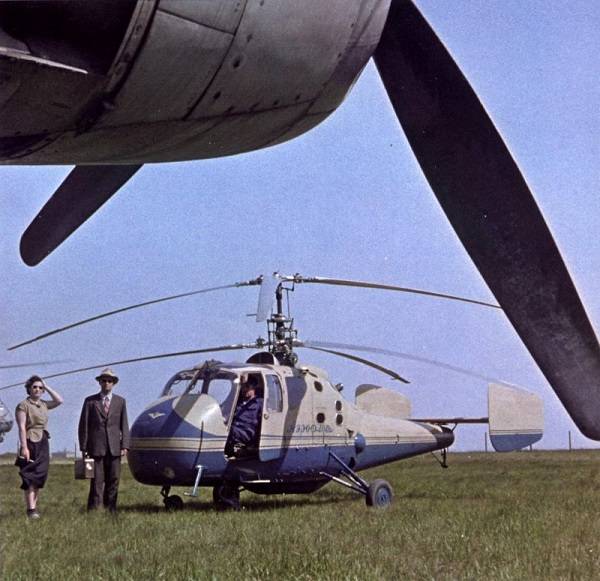
The civilian four-seater Ka-15 modification, the Ka-18 helicopter, is in civil livery at the airfield of the Flight Test Complex in Zhukovsky. Photo from http://army.lv
Perhaps there were some other, purely personal or smaller reasons, which ultimately led Nikolay Kamov to choosing a coaxial scheme as the ridge of his design bureau. As the famous aerodynamic scientist Leonid Wildgrube joked, one of those scientists who made a huge contribution to the development of the Soviet school of aerodynamics of a helicopter, "the coaxial scheme is obliged to all Nikolai Kamov". Indeed, no one in the world studied so deeply and intently the mechanics and design of the coaxial circuit, and no one built in such numbers successful coaxial helicopters.
"Ka-15 was designed very compact"
But back to the stories create ka-xnumx. After the fleet was instructed to develop this helicopter, an advance design was agreed with the customer’s tactical and technical tasks, work on the direct design of the machine was launched at OKB-15. Vladimir Barshevsky, one of Nikolay Kamov's closest associates, in his memoirs “From the inside of the design bureau”, described in detail in his memoirs about how they passed through. In particular, he describes the situation in which the Kamov Design Bureau began work on the first large-scale deck helicopter of the Soviet Navy:
“In early October 1951, N.I. Kamov was summoned to the Kremlin. About three hours later, he returned very upset and said that, besides him, A.N. Tupolev, S.K. Ilyushin, N.N. Bratukhin and M.L. Miles. The task of urgent creation of transport helicopters was discussed. Mil reported on the project for a twelve-seat Mi-4, and Kamov - on the Ka-14-2 project (a heavy transport and landing helicopter of a longitudinal scheme, capable of lifting 30-40 infantrymen in full gear. - Author's note). The production time for the machines was set at one year. Nikolai Ilyich objected that he needed at least two years. LP Beria was very dissatisfied with his answer. The next day, only M.L. Mil and ... A.S. Yakovlev and persuaded them to take on the task, promising unlimited help. Already on October 5, a government decree was issued on the creation of single-rotor and longitudinal transport helicopters for 12 and 24 people, respectively. Mil OKB was transferred to plant No. 3, Bratukhin's OKB was disbanded, and OKB-2 <...> was transferred to Tushino, where Mil was previously based. Thus, our project was actually transferred to Yakovlev.
The Mi-4 helicopter began rolling the main rotor in April 1952, in May 1953 the state tests were completed, and at the end of the year the first mass-produced vehicles were launched in Saratov. The Yak-24 made the first flight of 3 on July 1952. At the beginning of 1953, it was handed over for state tests, only in April, 1955 completed them and in August it was shown at a parade in Tushino. Kamov was right: you cannot make such a car for a year, but it’s dangerous not to agree with the high authorities.
Meanwhile, we again moved to an uncomfortable base, where we had to build the Ka-1040 series by the order of the Ministry of Antimonopoly Policy No. 23 from 1951 in October 10, and develop the Ka-15 ”.
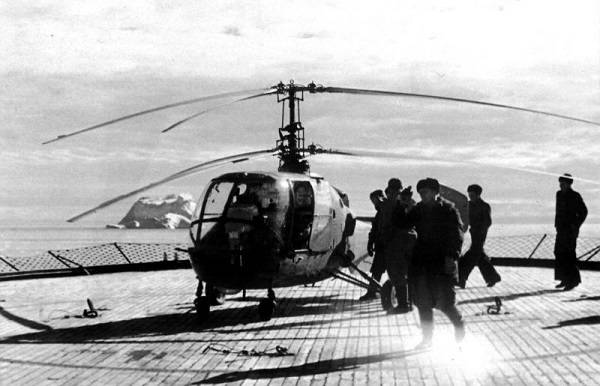
Ka-15 helicopter at the heliport of the legendary icebreaker "Yermak" during tests in Murmansk. Photos from the site
This move, which demonstrated the dissatisfaction of the “tops” with Kamov’s obstinacy and excessive autonomy, was another blow of fate that the designer and his subordinates experienced with their inherent resilience. Work on the creation of the Ka-15 continued, and soon the car began to acquire more and more complete outlines. Vladimir Barshevsky recalls:
“The Ka-15 helicopter intended for ships was designed very compact. Its length was almost half that of the Mi-1. It is not easy to place in a small volume all the equipment needed to search for submarines. <…> We were engaged in the search for the optimal layout of the helicopter with engineers V.I. Biryulin and B.Yu. Kostin, since the Chief Designer was at the state tests of the Ka-10 in Riga. Nikolai Ilyich Kamov, returning, looked through a dozen of the options we had invented, immediately chose the simplest and, in our opinion, the worst. It was the familiar wheeled chassis layout. According to him, firstly, with the float landing gear, we have already had time to exhaust ourselves on the Ka-8 and Ka-10, but wheels are still needed to move on the ground; secondly, landing on the ground on floats from the autorotation mode is an almost inevitable presence of a hood and, thirdly, even the Ka-10 was insured by specially trained people during takeoff and landing, otherwise the machine could enter into “earth resonance”, because damping in the cylinders was insufficient. "
So it happened that the first serial deck multipurpose helicopter of the Soviet Navy - and the first multi-purpose civilian helicopter of the coaxial scheme - got the usual chassis, and not floats. However, later on, while working on the Ka-15M, in one of the options, this car was placed on floats, but this modification did not become the main one.
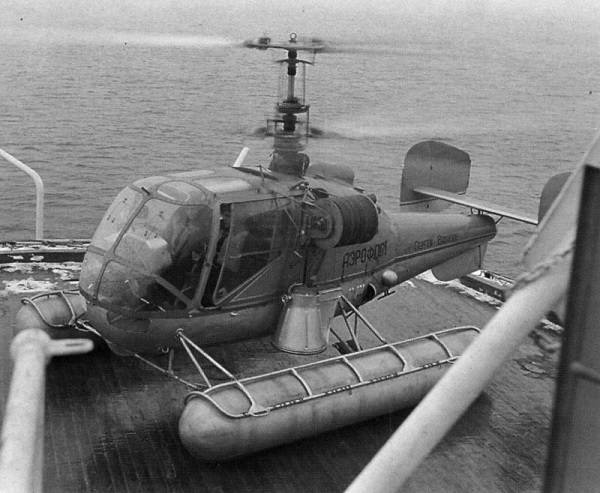
Ka-15 on floats while boarding the ship. The machine is marked “Aeroflot”, but it is equipped with a submersible hydroacoustic station with a winch on the left side, that is, it is anti-submarine modification. Photo from http://army.lv
Who raised the "Fifteen" in the air
Almost two years went away with Nikolai Kamov and the staff of his design bureau, as well as the workers of an experimental enterprise, in order to bring the new machine to embodiment, so to speak, in metal - and wood, since the design of the blades of both screws was wooden-metal. 14 April 1953, the first prototype of the Ka-15 helicopter, designed for life tests, took off. In his cockpit sat a test pilot of the Kamovsky Design Bureau Dmitry Yefremov.
This man played such a big role in the fate of the first serial helicopters of Nikolai Kamov that he deserves a detailed story. Muscovite, he began his journey into the sky at the Bauman flying club in 1941, and immediately after the war began he was sent to study at the Saratov Military aviation glider school. Since 1943, Efremov fought as part of the training airborne regiment of the Airborne Forces, on heavy gliders delivering ammunition, weapons and reconnaissance and sabotage groups to the front line. After the war, he remained to serve as a pilot in the airborne units, but in 1948 he was demobilized due to tuberculosis. Finding a job at that time of mass demobilization of soldiers and officers who had reclaimed their own was not easy, but Dmitry Efremov was lucky to get a job almost by profession: he began working as a mechanic in Nikolai Kamov's Design Bureau.
As the General Designer later recalled, Dmitry Efremov learned to fly by helicopters under the guidance of Chief Pilot Mikhail Gurov, one of the closest associates of Nikolai Kamov and the pilot who was at the origins of the design bureau. At first, the mechanics, who had already grown to the mechanic, began to trust "hanging" in the Ka-10 prototype machine on the retaining cable. Then he got the opportunity to control the helicopter, which was moving back and forth along two cables fixed with ends on the ground - this was the so-called “trille” simulator, invented by Gurov.
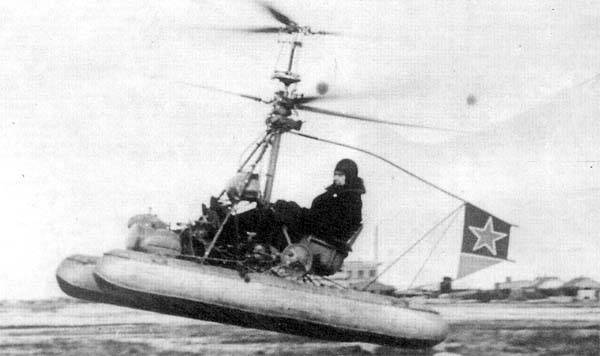
Test pilot Dmitry Efremov controls the Ka-10 helicopter, the third prototype. Photos from http://avia.pro
As a result, in September 1949 of the year, Kamov, who noticed an insistent motor mechanic-pilot, by his order appointed him a test pilot - and did not lose. According to the people who knew Dmitry Efremov, he was a real test pilot, that is, not only a pilot, but also an engineer and a designer who created a technique for balancing a coaxial rotor scheme. All the first large-batch helicopters of the OKB-2 - from Ka-15 to Ka-25 passed through his hands. Unfortunately, the chief pilot of the Kamov "firm" Efremov became under tragic circumstances. October 8 1949 of the year during the next test flight on the Ka-10 killed Mikhail Gurov, and since there were not many test pilots in the design bureau, Efremov was assigned to fly around the Ka-10 No. XXUMX.
Dmitry Efremov quickly showed himself as an attentive pilot who could not only notice everything that happens with the car, but also evaluate the reasons for such behavior. It is enough to give just one example. In April, 1949, Efremov was assigned to prepare a Ka-8 helicopter for training hang-ups on a leash. During the approach, due to the unreliable locking of the ball-joint nut, the thrust connecting the upper arm leash to the swashplate was disengaged, and the blades skewed. So, in the explanatory note on the fact of the accident, the pilot simply described what he felt and did, but also fairly accurately recreated the details of the emergency, describing in detail that the vanishing of the blades occurred in the right hemisphere, and why, in his opinion, it did.
So the former military glider pilot showed the most important qualities of a tester: a good reaction and the ability to see and remember the essential moments of an emergency situation. And the ability to coolly do everything to avoid a catastrophe - if it is possible in principle. Alas, once it turned out to be absolutely impossible: Dmitry Efremov, chief pilot of the OKB-2 Nikolai Kamov died on August 28 on 1962 during the crash of Ka-22 rotary wing that happened during the haul of a car from Tashkent to Moscow as part of acceptance tests.
But then, 14 of April of 1953, was still ahead: the development of the Ka-15 to state tests, and new cars, and the last flight in life. Now the main thing was different: to teach the new rotorcraft to fly, which was so expected in the navy.
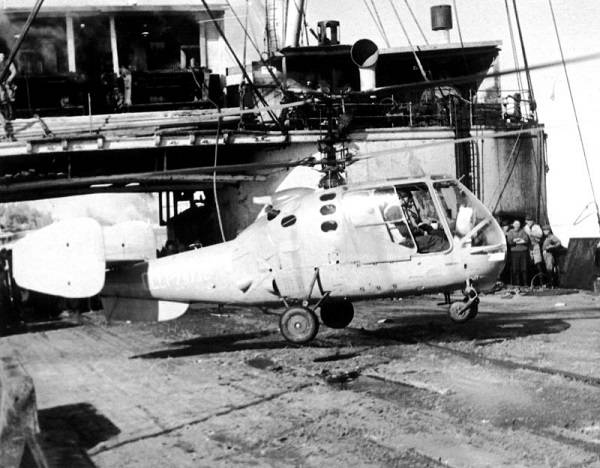
Ka-15 helicopter on the deck of a fishing vessel, where such machines were used as reconnaissance of a fishing beast. Photo from http://army.lv
Price for the right to be first
The process of finishing the Ka-15 was very difficult. As experts of the OKB Nikolai Kamov later acknowledged, at the G8 and the Top Ten, due to their relatively small size, many dangerous phenomena accompanying the coaxial scheme that was little studied at that time simply did not manifest themselves. But on the "tag" with all of them had to literally fight, carrying completely not figurative losses.
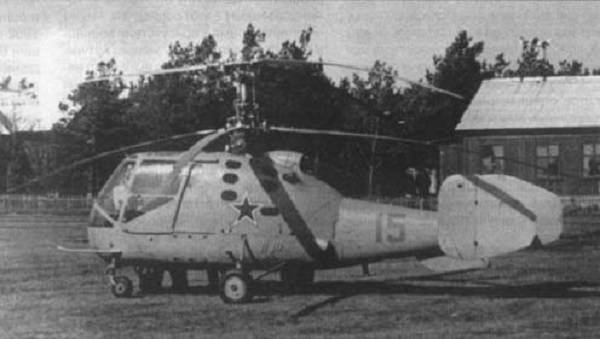
Drill Ka-15 Black Sea Fleet on one of the Crimean airfields. Photos from http://kollektsiya.ru
First of all, we had to deal with all sorts of vibrations that literally pursued these machines. First, we dealt with the vibrations of the rotors and coaxial propeller columns. Then they found out and eliminated the causes of the vibrations of the helicopter itself, both longitudinal and “ground resonance” (associated oscillations of the blades and the fuselage, which usually occur on the ground). Then we had to spend a lot of energy - and, alas, human lives - to eliminate the causes of overlap of blades, almost inevitable for helicopters of the coaxial scheme ... In a word, the “childhood diseases” inherent in any new car and all helicopters of this scheme, in Ka-15 I had a lot of it.
However, in May 1955, the state tests of the new machine, which took less than a month, were successfully completed, and soon military tests, which were carried out on single and group-based cruisers, came to an end. In particular, the cruiser Mikhail Kutuzov conducted comparative tests of the Mi-1 and Ka-15 helicopters. The main conclusion was obvious: the Mi-1 long tail boom practically excludes the possibility of using this helicopter on a ship during rolling.
The Ka-15 serial helicopter was launched at Ulan-Uda Aviation Plant in April 1956. And in March of the following year, new cars began to enter the line units. Unfortunately, they did not last long: because of the entire complex of “childhood diseases” Ka-15, several major accidents occurred with the participation of this machine, and in May 1963 were banned from flying these helicopters to the Navy. After that, the remaining helicopters of the navy gradually transferred to civil aviation, where the Ka-15 continued to fly until the second half of the 1970's.
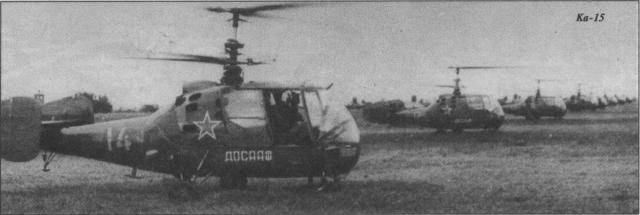
After dismissal from the Navy, the Ka-15 was actively used in the Soviet DOSAAF. Photos from http://alternathistory.com
Despite the relatively short lifespan of these helicopters, their creation and operating experience provided an excellent basis for the development and deployment in the fleet of other helicopters of the Nikolai Kamov Design Bureau. After all, as participants of the state tests noted, as a result, the flight performance of the “tag” turned out to be higher than the design. The car was carrying commercial cargo in 210 kg with a take-off weight of 1410 kg and engine power 280 hp. (Mi-1 took 255 kg with weight 2470 kg and power 575 hp), and the handling characteristics of a coaxial helicopter, and the compactness of the machine made it possible to take off and land from very limited areas. This is exactly what allowed Ka-15, and then the appeared modifications Ka-15M and Ka-18 (a purely civilian four-seat modification of a helicopter, capable of performing sanitary functions) to remain in the civilian fleet for two decades.
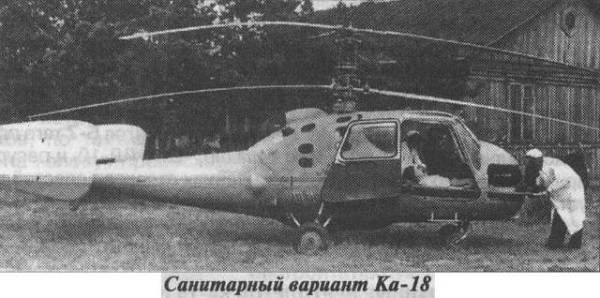
The Ka-18 differed from the Ka-15 in its large cabin size, which it was possible to adapt even to accommodate sanitary stretchers. Photos from http://alternathistory.com
During this time they managed to express themselves everywhere: on military exercises, on polar expeditions, and on whaling fleets, and as an agricultural one. The Ka-15 also performed many tasks in the fleet: it was an anti-submarine helicopter (since the load capacity of the tag did not allow it to be equipped with detection equipment and means of destruction, they were used in groups of three cars, each carrying its own PLO part) target designator for a complex of anti-ship cruise missiles KSSC, served as an observer and communications helicopter. In total, the X-NUMX Ka-375 helicopters were launched, counting and prototypes, which made it the first large-batch helicopter in the history of the Nikolai Kamov Design Bureau and the first large-scale deck helicopter in the Soviet Navy.
Performance characteristics of the Ka-15 helicopter
The length of the fuselage - 6,26 m
The diameter of the rotors - 9,96 m
Fuselage width - 2,85 m
Height - 3,35 m
Engine - 1 AI-14B, piston, air cooled
Power, kW - 1 x 188
Maximum speed —155 km / h
Cruising speed - 120 km / h
Ferry range - 520 km
Practical range - 278 km
Practical ceiling - 3500 m
Static ceiling - 600 m
Empty weight - kg 968
Takeoff weight - kg 1370
Maximum take-off weight —1460 kg
Payload mass - kg 300-364
Flight duration - 2,5 h
Information